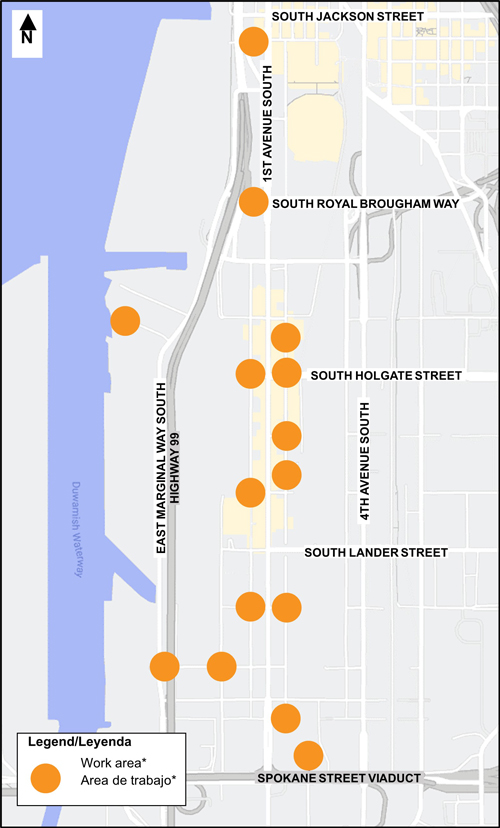Mouth of Duwamish Wet Weather Facilities
Learn about King County’s efforts to develop wet weather facilities to control combined sewer overflows in the area of the mouth of the Duwamish River.
April 2024 update
Upcoming survey work in the SODO neighborhood
King County is conducting survey work at several sites in the SODO neighborhood in April 2024. This work will help our team to learn about underground soil conditions and above ground building, roadway, sidewalk, vegetation, and utility locations as we progress our plans to reduce overflows from five combined sewer outfalls where the Duwamish River meets Elliott Bay.
What to expect
- Work hours 7:30 a.m. to 5 p.m. daily for approximately one month, starting as early as March 25, 2024.
- Work will take place for several hours at each location. We expect to be at each location for about one day.
- Work may involve temporary lane, shoulder, or sidewalk detours, noise, and slight vibrations. If detours are necessary, flaggers will be on site to assist vehicle and pedestrian movement. Detours will not be concurrent, and each will last up to eight hours.
Please watch for equipment and signs in the area, travel slowly to stay safe and follow direction from flaggers.

*Each dot on the map represents up to two survey locations/Cada punto en el mapa representa hasta dos ubicaciones de la encuesta
The Mouth of Duwamish Wet Weather Facilities are in the planning phase. For more information, check out the factsheet.
Sign up for our project email list using the link on the right side of this webpage.
Questions?
Contact Bibiana Ocheke-Ameh at 206-477-5604 or bibiana.ocheke-ameh@kingcounty.gov
Previous updates
King County is working on an effort called the Mouth of Duwamish Wet Weather Facilities that will reduce overflows from 5 combined sewer outfalls where the Duwamish River meets Elliott Bay.
We are evaluating options that control combined sewer overflows (CSOs) to comply with environmental laws. The CSOs were designed many decades ago to be overflow relief points in our sewer system during periods of heavy rain. Today, to better protect local water bodies, King County is investing in solutions to limit the number of overflows that occur and to ensure we are meeting regulatory requirements to protect water quality.
What we’re doing
King County is working to control 5 CSO outfalls in the area of the mouth of the Duwamish River. The outfalls (called Chelan, Hanford #2, Lander, Kingdome, and King Street) are located in the east and west waterways of the Duwamish River on both sides of Harbor Island and along the Seattle shoreline of Elliott Bay in the SODO neighborhood. This work fulfills legal requirements (called a consent decree) we have with the U.S. Environmental Protection Agency and the Washington State Department of Ecology.
King County has made great progress in controlling CSO outfalls in Puget Sound and other local water bodies. As of 2023, we've controlled 18 outfalls to reduce overflows to reduce pollution into local water bodies. But our work is not done yet. Controlling CSO outfalls at the mouth of the Duwamish River represents a large portion of the remaining CSO outfalls we strive to control.
The Mouth of Duwamish Wet Weather Facilities is one of the most complex efforts we will undertake. The effort will help King County be a good environmental steward by improving water quality. We must control CSO overflows and limit pollution to Duwamish River and Elliott Bay to do our part in creating healthy water bodies where communities and wildlife thrive.
About combined systems and CSOs
Much of Seattle was built using a combined sewer system. Combined sewer systems carry sewage and stormwater in the same pipe. They prevent sewer backups in homes, businesses, and streets during heavy rain. When heavy rains fill the pipes, CSO outfalls release stormwater and sewage into local water bodies.
Today, King County is modernizing a system that’s been in place for more than a century to ensure sustainable operations into the future by investing in more wet weather facilities. Since our CSO Control Program began in the 1980s, we’ve reduced the average CSO discharge volume from an estimated 2.3 billion gallons to about 1 billion gallons per year. Controlling CSO outfalls at the mouth of the Duwamish River represents a large portion of the remaining CSO outfalls we strive to control.
Key terms
Stormwater is the rain that falls on our roofs and streets and flows into storm drains. The water picks up what it touches, like oil from the road, yard chemicals, and pet waste. Then the polluted water runs off into local bodies of water — like the Duwamish River.
CSO outfalls are relief points designed in combined sewer systems that carry sewage and stormwater in the same pipe. They prevent sewer backups in homes, businesses, and streets during heavy rain. When heavy rain fills the pipes, CSO outfalls release sewage and stormwater into rivers, lakes, or Puget Sound.
Wet weather facilities are designed to treat a combination of stormwater and wastewater that fills pipes to overcapacity during periods of heavy rain.

 Translate
Translate